PH2 Tested: 2012 Yamaha YZF-R1
Now with Traction Control, just like the M1 MotoGP bike...
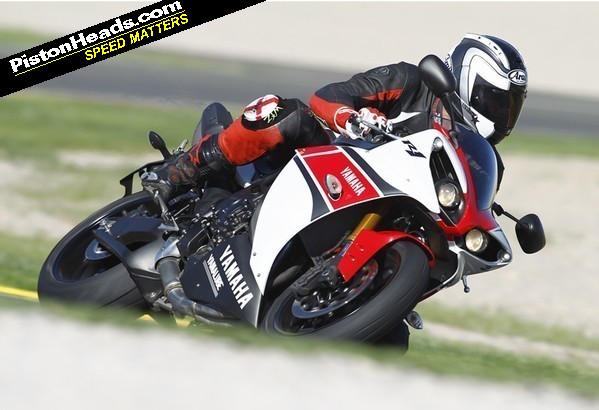
While the rest of the litre bikes (FireBlade, GSX-R1000, ZX-10R) had conventional inline four engines that fired every 180-degrees, Yamaha's new R1 had an uneven firing order. It fired at 0 - 270 - 180- 90 - 180-degrees, a development that Yamaha claimed helped eliminate 'inertial' torque. It's complicated, but in a nutshell every time a piston goes up and down it has to stop and start again, which creates uneven torque characteristics. On a bike the connection between the throttle and the power is essential for quick lap times as too much power, or bad throttle feel, equals slow lap times. The 'cross-plane' engine helps reduce the effect of the start-stop of the pistons and create a 'purer' torque delivery through its firing order. Does it work? Ben Spies won the 2009 World Superbike championship first time out on the R1 and Tommy Hill has just won the British Superbike title on the same bike - so in racing, yes. Oh, and the Yamaha MotoGP bike also uses a cross-plane motor and it has done ok...
On the road it is a different matter. The big thing about the R1's motor on the road it what it feels like. The 'cross-plane' configuration not only sounds completely different to an inline four, it behaves differently. Where inline fours deliver a smooth and relatively vibration free build-up of power, a cross-plane engine is smooth on a constant throttle, but kind of lumpy and rough under acceleration. Not in a bad way, but in a completely different way to a 'conventional' inline four - almost like a V-twin. That's the history lesson over, so what's new about the 2012 YZF-R1?
Well that's the thing, to be honest not a lot. The 2012 model has an identical chassis and motor to the bike launched in 2009 bar a few very small changes to the suspension, but it now comes with Traction Control fitted as standard.
Traction control is still in its infancy in bikes and there are two systems - one works on wheel speed sensors, one on monitoring spikes in the engine's revs. The R1 has wheel speed sensors, generally regarded as the best system. Why do you need TC on a bike? The rear wheel on the R1 has around 155bhp (Yamaha claim 180bhp at the crank) being delivered to the road through a tyre contact patch roughly the size of a squashed CD. If this breaks traction and you don't close the throttle in time (or you do and it grips when the bike is sideways) you have a 'highside', at which point the standard procedure is to leap about ten feet in the air and adopt a star shape with you legs and arms.
This hurts when you return to the ground - a lot. Just look on YouTube for evidence. Traction control means that mere mortals can open the throttle hard with the bike lent over without the fear of a crash. It is also very good on wet roads.
Yamaha's system has six different levels, so you can adjust while on the move according to your riding style or the amount of TC interference you want via an up and down button on the left hand switchgear. Testing the bike around the Valencia circuit in Spain I set the TC in on the highest setting and when at maximum lean in first gear I simply cracked the throttle wide open and held on, something I wouldn't recommend on a non-TC bike! With a warning light flashing (indicating the TC was activating) the bike leapt forward, stuttered a bit as the anti-wheelie kicked in (all part of the TC system), the fired out of the corner. As I was still on the bike I concluded the system worked well... I know this sounds a bit flippant, but an R1 can do about 100mph in first, so we aren't talking small speeds here, and this kind of test highlights if a system works or not at maximum stress.
Happy with this I upped the pace and dropped the TC to a lower setting. This model of R1 can be a bit sluggish to turn on track but Yamaha has added some subtle suspension alteration to the 2012 model, increasing the shock's spring's length and reducing its spring rate. This, along with a change of tyres to Dunlop's Sportmax Qualifiers, seems to have added a bit of urgency to the R1's rate of turn in. It's not as sharp as the more aggressive Kawasaki ZX-10R or BMW S1000RR, but it's certainly sportier than the 2010 model and feels very balanced while lent over.
At a speed that I would call 'fast trackday group' (I'm no BSB racer) the traction control was very impressive. Again, being brutal with the throttle to encourage slides, I found that in setting four and five the TC would catch slides and retard the power before my brain, and throttle hand, could react, which is all you can ask for really.
How do I know this? When I felt the bike move the yellow 'TC warning' light would simultaneously flick on to tell me. It seems a very impressive system and despite my best gorilla-handed riding the TC prevented what would have been a few huge accidents when the road tyres started to become overworked due to the 32-degrees heat and constant track use. On the road it would be a Godsend in the wet.
However there is a problem. Due to the drive the TC gives you out of corners it was all too easy to arrive at the next bend 10mph faster than I was anticipating, something that TC can't help with! That's where rider skill starts to get involved and with all the electronic aids that are now finding their way into motorcycling (ABS, TC, anti-wheelie) I do worry that riders will come to rely on electronics rather than good old feel. Oh yes, and anti-wheelie on the R1 is only on 6 &5 TC settings, you can still hoist one up if you wish!
The R1 comes in a choice of red, blue, matt grey or the stunning '50th Anniversary' colours of red/white, which is limited to 2,000 worldwide. Actually a few less after some of the French journos got over-excited...
No word on price, but expect around £13,600 for a stock colour with a premium for the special.
Gassing Station | Biker Banter | Top of Page | What's New | My Stuff

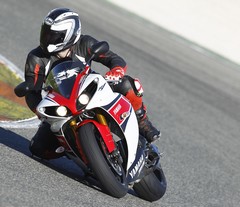
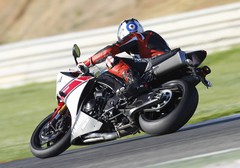
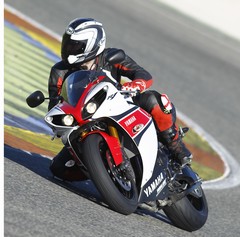

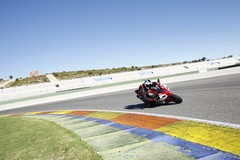
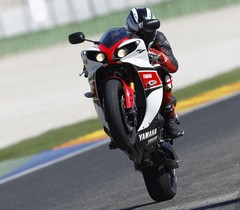



 to our man in the saddle.
to our man in the saddle.